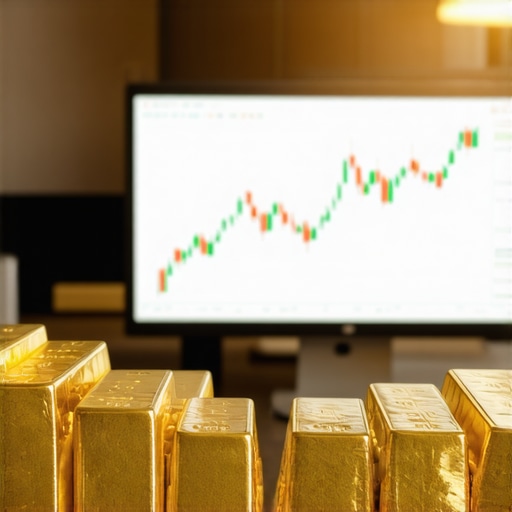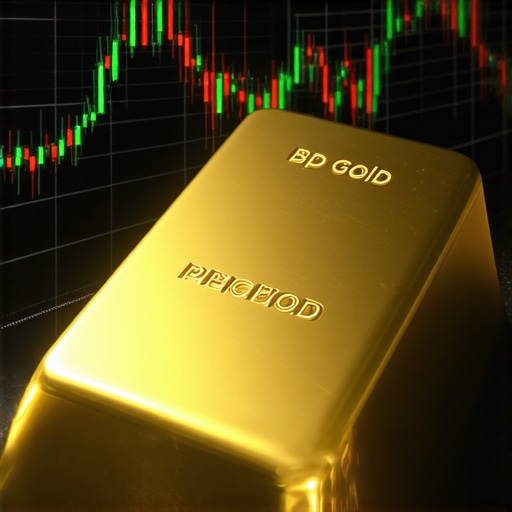Understanding Gold Price Dynamics for 2025
As we look ahead to 2025, the future of gold prices is a topic of great interest for investors and market analysts alike. The dynamics of gold pricing are influenced by numerous factors, ranging from economic indicators to geopolitical events. In this article, we will explore key trends that are likely to shape the gold market in the coming year.
The Impact of Economic Conditions on Gold Prices
The health of the global economy plays a significant role in determining gold prices. Generally, during periods of economic uncertainty, gold tends to be viewed as a safe-haven asset. Factors such as inflation rates, interest rates, and currency fluctuations can all contribute to the volatility of gold prices. For instance, if inflation continues to rise, more investors might flock to gold as a hedge against currency devaluation. This trend could lead to increased demand, thereby driving prices higher.
Central Bank Policies and Their Influence
Central banks around the world hold substantial amounts of gold in their reserves, and their policies can significantly affect gold prices. In 2025, we may see continued buying from central banks as they diversify their assets and look to stabilize their economies. Understanding how central bank gold purchases influence market prices can provide valuable insights for investors. If central banks continue to accumulate gold, this could support higher prices in the long term.
Geopolitical Events and Gold Demand
Geopolitical tensions often lead to increased demand for gold, as investors seek security amid instability. Events such as trade wars, conflicts, and elections can create uncertainty in financial markets. In 2025, we may witness several geopolitical events that could trigger a surge in gold prices. Investors should stay informed about these developments to better anticipate how they might affect their portfolios.
Technological Advances in Gold Trading
Advancements in technology are also reshaping how gold is traded and consumed. The rise of digital gold and gold-backed cryptocurrencies is emerging as a trend worth monitoring. These innovations could attract a new generation of investors who prefer digital assets. Furthermore, as more people become aware of the benefits of gold IRAs and digital trading platforms, demand for gold may increase, impacting prices positively.
Investor Sentiment and Market Trends
Finally, understanding investor sentiment is crucial when forecasting gold prices. Market psychology can lead to significant price movements; therefore, keeping an eye on investor behavior and market trends is essential. Are investors feeling optimistic about the stock market, or are they leaning towards safer assets like gold? Tracking these sentiments will help predict potential shifts in demand.
Analyzing Gold Market Trends for 2025
As we delve deeper into the gold market for 2025, it’s essential to analyze various trends that will shape the investment landscape. One significant trend is the growing interest in gold investments among millennials and younger generations. This shift in investor demographics is likely to impact demand and pricing significantly, as younger investors often prioritize sustainability and ethical sourcing in their investment choices.
Emerging Investment Vehicles: Gold ETFs and Mutual Funds
In recent years, there has been a notable rise in the popularity of gold exchange-traded funds (ETFs) and mutual funds. These financial instruments offer investors an easy way to gain exposure to gold without the need to physically hold the metal. Understanding the nuances of investing in gold mutual funds and their potential benefits can be crucial for both novice and experienced investors. With the anticipated growth of gold ETFs, we can expect fluctuations in prices influenced by their trading volumes.
Global Economic Recovery and Gold
As economies begin to recover from the disruptions caused by global events, the demand for gold will likely fluctuate based on economic conditions. A robust recovery could lead to increased interest rates, which historically have a negative correlation with gold prices. Conversely, a slow recovery may push investors back to gold as a safe-haven asset, maintaining its allure. Investors should monitor economic indicators closely to navigate these potential shifts effectively.
Supply Chain Dynamics and Gold Availability
The availability of gold in the market is influenced by various supply chain factors. Mining operations, geopolitical stability in gold-producing regions, and regulatory changes can all impact supply. In 2025, any disruptions in these areas could lead to supply shortages, driving prices higher. Understanding the complexities of gold mining and demand trends will be essential for investors looking to make informed decisions.
Technological Innovations in Gold Trading
Technological advancements are transforming how gold is traded, with innovations such as blockchain and digital currencies entering the space. These technologies offer transparency and efficiency, potentially attracting a new wave of investors. As the market evolves, those interested in gold trading techniques will need to stay abreast of these changes to remain competitive.
The Role of Gold as a Hedge Against Inflation
Gold has long been considered a reliable hedge against inflation, and this perception is likely to persist in 2025. As inflation rates rise in various economies, investors may flock to gold to preserve their wealth. Understanding how gold functions as a hedge can empower investors to make strategic decisions regarding their portfolios. The interaction between inflation and gold prices will continue to be a vital area of focus for market participants.
As we approach 2025, ongoing monitoring of these trends will be crucial for investors looking to navigate the complexities of the gold market. The interplay of economic conditions, technological advancements, and investor behavior will ultimately shape the landscape for gold investments. By staying informed and adaptable, investors can position themselves to capitalize on emerging opportunities.
Understanding Investment Strategies for Gold in 2025
As 2025 approaches, investors are increasingly looking for effective strategies to capitalize on gold’s potential. The evolving market landscape necessitates a comprehensive understanding of various investment vehicles and their implications. From physical gold to digital assets, each option holds unique benefits and challenges.
Evaluating Physical Gold Investments
Investing in physical gold remains a popular choice for many. Gold bullion, coins, and bars offer tangible assets that can be held securely. When considering how to buy gold bullion, investors should focus on factors such as purity, weight, and market demand. Ensuring the quality of gold purchased can significantly impact the investment’s long-term value.
Gold ETFs and Mutual Funds: Pros and Cons
Exchange-traded funds (ETFs) and mutual funds have gained traction as convenient alternatives to physical gold. These financial instruments provide diversified exposure and can be traded like stocks. However, understanding the pros and cons of gold ETFs is crucial. While they offer liquidity and lower storage costs, investors must be aware of management fees and market volatility associated with these funds.
Gold Mining Stocks: A Different Approach
Another avenue to explore is investing in gold mining stocks. By purchasing shares in companies that mine gold, investors can potentially benefit from price increases in gold without directly holding the metal. However, the performance of these stocks is influenced by various factors, including operational efficiency and geopolitical risks. Understanding how to successfully invest in gold mining stocks requires careful research and analysis of individual companies and the mining sector.
Gold as a Hedge Against Market Volatility
Gold’s reputation as a safe-haven asset makes it an attractive option during periods of market volatility. Investors often turn to gold to mitigate risks associated with economic downturns. This trend is expected to continue in 2025, particularly if inflation rates remain high. By understanding how gold can serve as a hedge, investors can make strategic decisions to protect their wealth.
Monitoring Global Economic Indicators
Keeping an eye on global economic indicators is vital for any investor looking to navigate the gold market effectively. Factors such as interest rates, inflation, and currency strength can directly impact gold prices. By forecasting gold prices based on these indicators, investors can better position their portfolios to respond to market changes.
Technological Innovations in Gold Trading
As technology advances, new trading platforms and digital currencies are changing how investors engage with the gold market. Innovations such as blockchain technology promise enhanced security and efficiency in transactions. Those interested in gold trading techniques should stay updated on these developments to remain competitive in an evolving landscape.
By exploring these diverse investment strategies and understanding market dynamics, investors can make informed decisions that align with their financial goals. As we move further into 2025, the interplay of economic factors, investment choices, and market psychology will continue to shape the gold landscape, presenting both challenges and opportunities for savvy investors.
Evaluating Gold Investment Strategies in 2025
With the evolving landscape of gold investments, it is essential for investors to evaluate various strategies to maximize their potential returns. Whether you are considering physical gold, ETFs, or gold mining stocks, each option has its unique advantages and challenges. This section delves into the different approaches investors can take to navigate the gold market effectively in 2025.
Investing in Physical Gold: Key Considerations
Physical gold, including bullion, coins, and bars, continues to be a popular choice for many investors. The tangible nature of these assets provides a sense of security, especially during economic uncertainty. When buying gold bullion, investors should focus on factors like purity, weight, and market demand. Ensuring the quality of your gold investment is crucial, as it can significantly impact its long-term value and liquidity.
Gold ETFs: A Convenient Alternative
Exchange-traded funds (ETFs) have surged in popularity as a convenient alternative to owning physical gold. Gold ETFs allow investors to gain exposure to gold prices without the need for physical storage. However, it is essential to understand the pros and cons of gold ETFs. While they offer liquidity and lower storage costs, investors must be aware of management fees and potential market volatility that could affect their investments.
Diversifying with Gold Mining Stocks
Investing in gold mining stocks presents a different approach to gaining exposure to the gold market. By purchasing shares in mining companies, investors can benefit from price increases in gold without directly holding the metal. However, the performance of these stocks is influenced by various factors, including operational efficiency and geopolitical risks. Aspiring investors should research how to successfully invest in gold mining stocks to identify companies with strong growth potential.
Gold as a Hedge Against Inflation
Gold’s reputation as a reliable hedge against inflation makes it an attractive option during periods of rising prices. As inflation rates continue to fluctuate, investors often gravitate toward gold to preserve their wealth. Understanding how gold functions as a hedge can empower investors to make strategic decisions regarding their portfolios, especially in uncertain economic climates.
Monitoring Economic Indicators for Informed Decisions
To navigate the gold market effectively, keeping an eye on global economic indicators is vital. Factors such as interest rates, inflation, and currency strength can directly impact gold prices. By forecasting gold prices based on these indicators, investors can better position their portfolios to respond to market changes and capitalize on emerging opportunities.
Technological Innovations Transforming Gold Trading
As technology continues to advance, new trading platforms and digital currencies are changing how investors engage with the gold market. Innovations such as blockchain technology promise enhanced security and efficiency in transactions. Those interested in gold trading techniques should stay updated on these developments to remain competitive in an evolving landscape. Understanding these innovations can unlock new opportunities for savvy investors, allowing them to take advantage of the latest market trends.
Frequently Asked Questions about Gold Investments in 2025
What factors will influence gold prices in 2025?
The key factors influencing gold prices in 2025 include economic conditions, central bank policies, geopolitical events, and investor sentiment. Monitoring inflation rates, interest rates, and global stability will be crucial for predicting price trends.
How can I invest in gold in 2025?
Investors can choose from various avenues to invest in gold, such as purchasing physical gold (bullion, coins), investing in gold ETFs or mutual funds, and buying shares of gold mining companies. Each method has its pros and cons, and it’s essential to evaluate them based on your investment goals.
Is gold a good hedge against inflation?
Yes, gold has historically been viewed as a reliable hedge against inflation. As inflation rises, many investors seek gold to preserve their purchasing power, making it a popular choice during inflationary periods.
What are the risks of investing in gold mining stocks?
Investing in gold mining stocks carries various risks, including operational challenges, geopolitical risks, and fluctuations in gold prices. Investors should conduct thorough research on individual companies and the gold mining sector to mitigate these risks effectively.
How do economic indicators affect gold prices?
Economic indicators such as interest rates, inflation, and currency strength directly impact gold prices. Generally, higher interest rates can lead to lower gold prices, while rising inflation may increase demand for gold as a safe-haven asset.
What are the advantages of gold ETFs over physical gold?
Gold ETFs offer several advantages over physical gold, such as liquidity, lower storage costs, and ease of trading. They allow investors to gain exposure to gold prices without the need for physical storage and security concerns.
How can I monitor gold market trends effectively?
To monitor gold market trends, investors should regularly follow economic news, track inflation rates, analyze central bank policies, and observe geopolitical developments. Utilizing financial news websites and market analysis reports can provide valuable insights.
What technological advancements are impacting gold trading?
Technological advancements such as blockchain, digital currencies, and innovative trading platforms are transforming gold trading. These technologies enhance transaction security and efficiency, attracting a new generation of investors to the gold market.
Why is understanding gold demand trends important?
Understanding gold demand trends is critical for investors as it helps predict price movements. Factors such as jewelry demand, industrial uses, and investment demand can significantly affect the overall supply and demand balance in the market.
How can I stay informed about gold investment opportunities?
Staying informed about gold investment opportunities involves following trusted financial news outlets, subscribing to investment newsletters, and engaging with expert analysis on gold market trends. Networking with other investors and attending industry conferences can also provide valuable insights.
Authority Resources for Gold Investment Insights
For those looking to deepen their understanding of gold investments, consider exploring the following reputable sources:
- Kitco News – A leading source for precious metals news and market analysis.
- World Gold Council – Provides comprehensive research and insights on gold demand, investment, and market trends.
- Investopedia – Offers educational articles and guides on investment strategies, including gold.
- Bloomberg Commodities – Features market data, analysis, and insights on commodity trading, including gold.
- Reuters – Trusted news source for financial markets and commodities, including gold pricing and trends.
By leveraging these resources, investors can enhance their knowledge and make informed decisions in the dynamic gold market.
Conclusion: Navigating Gold Investments in 2025
As we approach 2025, understanding the dynamics of gold investments is more crucial than ever. With various investment vehicles available, from physical gold to ETFs and mining stocks, investors can tailor their strategies to align with their financial goals. Keeping an eye on economic indicators, geopolitical developments, and technological innovations will help investors navigate the complexities of the gold market effectively. Ultimately, staying informed and adaptable will empower investors to capitalize on emerging opportunities, ensuring they are well-positioned for success in the world of gold investments.










The article provides a comprehensive look at the multiple factors influencing gold prices heading into 2025, especially highlighting how economic conditions and central bank policies play pivotal roles. From my experience watching market trends, the correlation between inflation and gold demand really stands out. When inflation rises, it seems more investors flock towards gold as a safeguard against currency devaluation, which this post rightly emphasizes. Another aspect I find intriguing is the emerging influence of technological innovations like digital gold and gold-backed cryptocurrencies. These developments could redefine how people invest in gold, making it more accessible to younger, tech-savvy investors who might prioritize convenience and digital assets over physical gold. However, I wonder how these new forms of gold investment will impact traditional physical gold markets and mining stocks in the long term. Will the rise of digital platforms dilute demand for physical gold, or might it actually broaden overall interest in gold as an asset class? It would be interesting to hear how others think these technological shifts could reshape gold investment strategies moving forward.